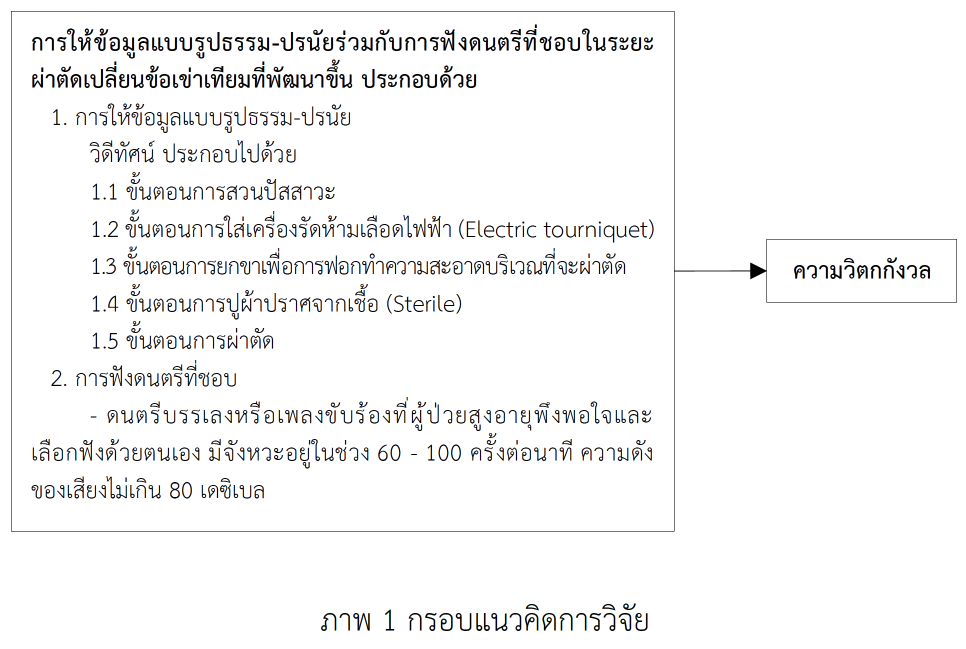THE EFFECT OF CONCRETE-OBJECTIVE INFORMATION AND PREFERRED MUSIC LISTENING ON PERIOPERATIVE ANXIETY DURING TOTAL KNEE ARTHROPLASTY IN OLDER ADULTS UNDER SPINAL ANESTHESIA
Keywords:
older adult, knee osteoarthritis, total knee arthroplasty, anxiety, information, musicAbstract
This study was a randomized controlled research aiming to explore the effects of concrete-objective information and preferred music listening on perioperative anxiety during total knee arthroplasty under spinal anesthesia in elderly patients at the Faculty of Medicine, Vajira Hospital, Navamindradhiraj University. The sample consisted of 56 patients. Blocked randomization was used to categorize the patients into experimental (n = 28) and control (n = 28) groups. The experimental group received concrete-objective information and preferred music listening on perioperative anxiety during surgery. The control group received regular nursing care. The research tools were a personal data questionnaire and a self-report measure of anxiety (Spielberger, 1983) with a reliability of 0.80. The data were analyzed by using frequency, percentage, mean, standard deviation, and a t-test.
The results revealed that the anxiety level among the experimental group was statistically lower than before receiving the concrete-objective information and preferable music listening on perioperative anxiety (Preoperative; M = 52.46, SD = 5.27, Intraoperative; M = 47.46, SD = 7.49, t = 4.43, p = .000) and lower than the control group who received regular nursing care with p < .05. (The experimental group; M = 47.46, SD = 7.49, The control group; M = 51.36, SD = 7.5, t = 1.94, p = .03)
Therefore, concrete-objective information and preferred music listening can be implemented to reduce anxiety during total knee arthroplasty in older adults under spinal anesthesia.
Downloads
References
Bansal, P., Kharod, U., Patel, P., Sanwatsarkar, S., Patel, H., & Kamat, H. (2010). The effect of music therapy on sedative requirements and haemodynamic parameters in patients under spinal anaesthesia: A prospective study. Journal of Clinical and Diagnostic Research for doctors, 4, 2782-890.
Basak, F., Hasbahceci, M., Guner, S., Sisik, A., Acar, A., Yucel, M., . . . Bas, G. (2015). (2015). Prediction of anxiety and depression in general surgery inpatients: A prospective cohort study of 200 consecutive patients. International Journal of Surgery, 23, 18-22. https://doi.org/10.1016/j.ijsu.2015.09.040
Choombuathong, A., Yimnoi, C., & Samma, C. (2017). Music therapy. 78 Huachiew Chalermprakiet Science and Technology Journal, 3(2), 77-87.
de Luca, M. L., Ciccarello, M., Martorana, M., Infantino, D., Letizia Mauro, G., Bonarelli, S., & Benedetti, M. G. (2018). Pain monitoring and management in a rehabilitation setting after total joint replacement. Medicine, 97(40),e12484. https://doi.org/10.1097/MD.0000000000012484
Dumkoengtham, S., Honsamsijad, Y., & Thungjaroenkul, P. (2021). Effect of using video media to prepare the patient before undergone anesthesia on knowledge and anxiety in orthopedic surgery patients, Phrae hospital. Journal of the Phrae Hospital, 29(1), 50-64.
Feng, J. E., Novikov, D., Anoushiravani, A. A., & Schwarzkopf, R. (2018). Total knee arthroplasty: Improving outcomes with a multidisciplinary approach. Journal of multidisciplinary healthcare, 11, 63-73. https://doi.org/10.2147/JMDH.S140550
Johnson, J. (1999). Self-regulation theory and coping with physical illness. Research in Nursing and Health, 22(6), 435–448.
Kampeera, K. (2019). The effects of a self-regulation promoting program on anxiety, practices, and knee range of motion among patients with total knee arthroplasty (Doctoral dissertation). Naresuan university, Phitsanulok.
Kang, H. (2021). Sample size determination and poweranalysis using the G*Power software. Journal ofEducational Evaluation for Health Professions, 18, 17-28. http://doi.org/10.3352/jeehp.2021.18.17
Kotchabhakdi, N., Vorakitphokatorn, S., & Nissaisuk, M. (1983). The state-trait anxiety inventory.
Kukreja, P., Talbott, K., MacBeth, L., Ghanem, E., Sturdivant, B. A., Woods, A., Potter, A. W., & Kalagara, H., (2020). Effects of music therapy during total knee arthroplasty under spinal anesthesia: A prospective randomized controlled study. The Cureus Journal of Medical Science, 12(3), e7396. https://doi.org/10.7759/cureus.7396
Kusalaruk, P., & Nakawiro, D. (2012). A validity study of the Mini-Cog test in Thai dementia patients Ramathibodi Medical Journal, 35, 264-271.
Lepage, C., Drolet, P., Girard, M., Grenier, Y., & de Gagné, R. (2001). Music decreases sedative requirements during spinal anesthesia. Anesthesia & Analgesia, 93(4), 912-916. https://doi.org/10.1097/00000539-200110000-00022
National Health Security office. (2017). Result. Retrieved from https://www.nhso.go.th/frontend/page-about _result.aspx
Nigussie, S., Belachew, T., & Wolancho, W. (2014). Predictors of preoperative anxiety among surgical patients in Jimma University Specialized Teaching Hospital, South Western Ethiopia. BMC Surgery, 14, 67. https://doi.org/10.1186/1471-2482-14-67
Pasitchakrit, P. (2017). Teaching documents for the course anesthesiology title spinal anesthesia. Anesthesiology, Medical Programme Srinakharinwirot University.
Permpech, R., & Butsripoom, B. (2016). The effect of music therapy on anxiety level in patients under going caesarean section. Journal of The Royal Thai Army Nurses, 17(3), 34-43.
Polkaew, J., & Rodpal, J. (2017). A result of preparation program of knee replacement surgery to an anxiety of the elderly patients with knee osteoarthritis. Journal of Preventive Medicine Association of Thailand, 7(3), 251-261.
Pokharel, K., Bhattarai, B., Tripathi, M., Khatiwada, S., & Subedi, A. (2011). Nepalese patients' anxiety and concerns before surgery. Journal of Clinical Anesthesia, 23(5), 372-8. https://doi.org/10.1016/j.jclinane.2010.12.011
Sigdel, S. (2015). Perioperative anxiety: A short review. Journal of Perioperative Medicine, 1(4), 107-108. https://doi.org/10.15761/GAPM.1000126
Sjöling, M., Nordahl, G., Olofsson, N., & Asplund, K. (2003). The impact of preoperative information on state anxiety, postoperative pain and satisfaction with pain management. Patient Education and Counseling, 51(2), 169-176. https://doi.org/10.1016/s0738-3991(02)00191-x
Speilberger, C. (1972). Anxiety: Current trends in theory and research. Academic Press.
Sroisong, S., Rueankon, A., Fuongtong, P., & Srathong, P. (2019). Nursing care for elderly people with knee osteoarthritis. Region 11 Medical Journal, 33(2), 197-209.
Ting, K. E. L., Ng, M. S. S., & Siew, W. F. (2013). Patient perception about preoperative information to allay anxiety towards major surgery. International e-Journal of Science, Medicine & Education, 7(1), 29-32.
Traiyawong, R., Kamaloporn, P., & Hemrungroj, K., Konkaisart, T., & Mewut, S. (2011). The effect of music on patients’ intra-operative anxiety in orthopedic surgery under spinal anesthesia. Thai Journal of Anesthesiology, 37(4), 206-218.
Trongsakul, S., Lambert, R., Clark, A., Wongpakaran, N., & Cross, J. (2015). Development of the Thai version of Mini-Cog, a brief cognitive screening test. Geriatrics and Gerontology International, 15(5), 594-600.

Downloads
Published
How to Cite
Issue
Section
License
Copyright (c) 2022 JOURNAL OF THE POLICE NURSES

This work is licensed under a Creative Commons Attribution-NonCommercial-NoDerivatives 4.0 International License.
ผลงานที่ได้ตีพิมพ์แล้วจะเป็นลิขสิทธิ์ของวารสารพยาบาลตำรวจ














